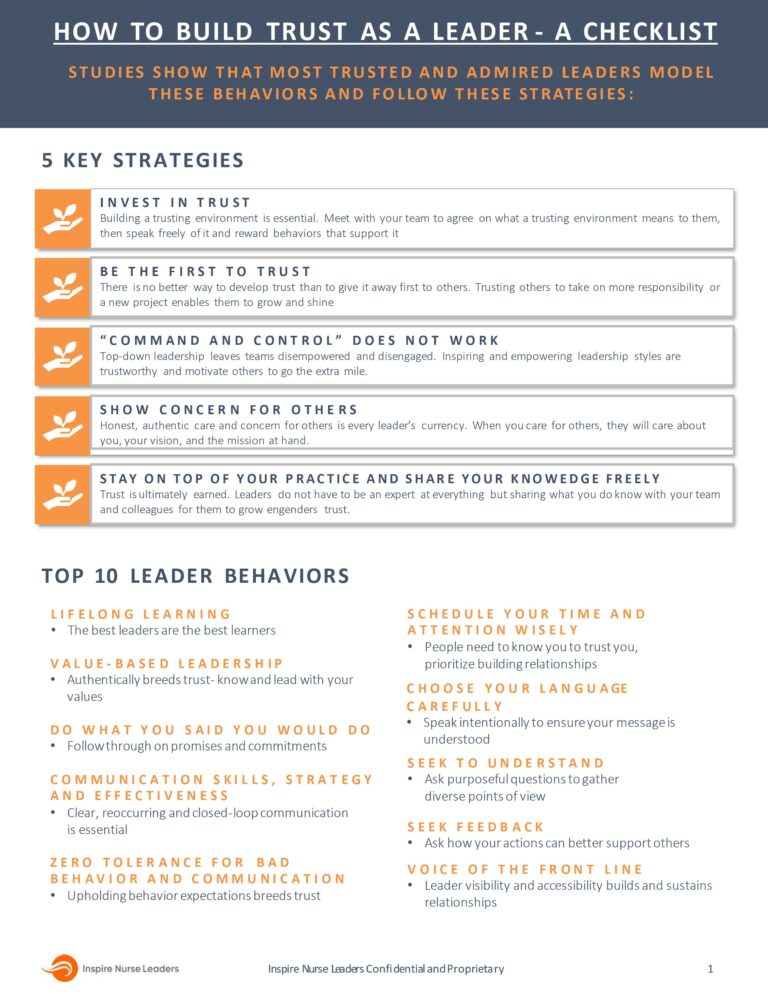Tapping the Power of Teamwork in Today’s Healthcare Organizations
High Trust Teams Deliver Exceptional Performance and Combat Turnover and Engagement Challenges

“Not finance. Not strategy. Not technology. It is teamwork that remains the ultimate competitive advantage, both because it’s so powerful and so rare.”
– Patrick Lencioni
In our modern workplaces eroding trust, constant employee turnover, and high stakes financial hurdles have become business as usual. The challenge for leaders is clear: prioritize the cultivation of robust, high performing teams to overcome these perpetual challenges.
Nowhere is this more vital than in healthcare, where teamwork lies at the center of the delivery of safe and effective care delivery. Whether as part of a committee, a peer group, or by discipline, we all function as integral members of a team. Nurse leaders today are continually challenged to create an environment where employees feel valued, engaged and supported. In short, they are expected to create cultures where their people thrive. This kind of environment is not created by mere chance. It’s through the collective efforts of these individuals that a team’s performance and quality are forged.
However, in my experience working with Nurse Leaders, I’ve noticed a concerning trend: team building is often overlooked as a crucial component of intentional development and performance strategies. Is this oversight yet another symptom of inadequate support for education and development? Or could it be attributed to the fact that Nurse Leaders currently shoulder spans of control and responsibility higher than those of any other leaders in the hospital? The reality is, they often find themselves lacking the time and mental bandwidth to devise a strategic approach to cultivating high-performing teams.
Now considered a foundational team-building text and necessary reference, Patrick Lencioni’s book, The Five Dysfunctions of a Team,1 provides diagnostic insights into team dysfunction but also practical solutions with universal relevance. Lencioni labels the first dysfunction as “Absence of Trust.” He contends that when team members fear vulnerability and are reluctant to open up about their weaknesses, mistakes, or concerns, this lack of trust leads to guarded communication, hidden agendas, and a lack of collaboration. It ultimately hinders the team’s ability to achieve its goals.
This Harvard Business Review article “How High Performing Teams Build Trust” 2 also links trust to high performing teams. In the article psychologist Ron Friedman, Ph.D. makes this important point, “Conversations about cultivating trust at work often focus on the relationship between managers and employees. While useful, this approach represents only half the equation. As important — if not more so — is establishing trust between teammates. After all, most employees work in teams, and the lion’s share of their daily experience involves interacting with colleagues, often in the absence of a boss.”
The Nurse Leaders Role in Creating a Culture of Trust
Crafting a culture of trust within a team is a journey rather than a destination. It’s a process that requires deliberate effort and commitment. However, there are proven leadership behaviors grounded in evidence that significantly contribute to the establishment of such a culture. These behaviors, when consistently practiced, pave the way for the development of a robust culture of trust.
Five Key Behaviors:
- Invest Time & Attention in Trust – Don’t just assume that trust will occur naturally. Meet with your team to agree on what a trusting environment means to them, then speak freely of it and reward behaviors that support it.
- Be the First to Trust – Set the example. Model the way. There is no better way to develop trust than to give it away first to others. Trusting others to take on more responsibility or a new project enables them to grow and shine.
- Ditch “Command & Control” Tactics – Top-down leadership leaves teams frustrated, disempowered, and disengaged. Inspiring and empowering leadership styles are key to creating trusting teams that are motivated to go the extra mile.
- Show Your Concern – Honest, authentic care and concern for others is every leader’s currency. When you show that you care for others, they will not only care about you, your vision, and the mission at hand, they will trust that you have their best interests top of mind.
- Share Expertise and Information Freely – Leaders do not have to be an expert at everything but sharing what you do know (both skills and knowledge) with your team and colleagues sets them up for success and nurtures trust.

Please fill out the form below to download INL’s Trust Checklist:
Building a High-Performing Teams Culture
While team-building workshops can serve as an initial catalyst, they are just the beginning of a more comprehensive approach to creating a high-performing team culture. Realizing tangible benefits from such workshops requires a strategic, evidence-based approach, coupled with ongoing commitment to improvement. Nurse Leaders must prioritize long-term intentional development, embracing and adhering to proven strategies to cultivate a culture of high trust and peak performance within their teams.
Three Key Strategies:
1. Leader Development
2. No One-and-Done Team Building Workshops
3. Leverage Role-Based Group Coaching
This contemporary, scalable approach to leadership development simultaneously blends both individual competency building with team collaboration, trust, and performance over a 6-12 month period. Powered by seasoned coaches and educators, these programs ensure a comprehensive approach to knowledge acquisition, skill development and the application of newly acquired behaviors in real-world scenarios. Unlike traditional leader fellowships and residencies, which may benefit a single attendee and their immediate teams, group coaching programs operate on the principle that “a rising tide lifts all boats.”
Key Take-Aways
-
By nurturing trust, collective growth, and team cohesion among participants strategic leadership programs yield broader organizational outcomes.
-
The ripple effects of enhanced collaboration, shared expertise, and heightened performance resonate throughout the organization, driving success beyond individual achievements. Significant ROI is reflected in retention and engagement and improved patient outcomes.
-
Group coaching programs represent a strategic and scalable investment in organizational development, fostering a culture of continuous improvement and collective excellence.
-
It’s time to leave behind outdated strategies that fail to harness the full potential of teamwork and instead, prioritize best practices that leverage the collective power of the group.

Lori Armstrong DNP, RN NEA-BC
CEO & Chief Clinical Officer
References:
- Lencioni, P. (2002) The Five Dysfunctions of a Team. Wiley & Sons.
- Friedman, R. (2024). How high performing teams build trust. Harvard Business Review https://hbr.org/2024/01/how-high-performing-teams-build-trust
- Inspire Nurse Leaders (2024) Nurse Leader Pulse Survey Executive Summary
Interested in learning about Inspire’s leadership development and coaching solutions? We believe in the power of collaboration and open dialogue. Contact us today to get started.


